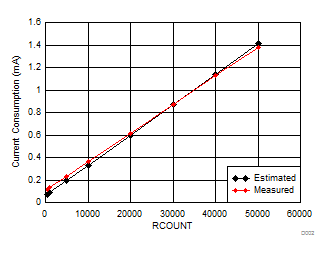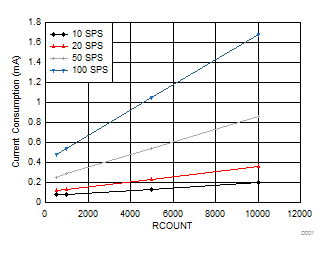SNOA949 May 2016 LDC1312 , LDC1312-Q1 , LDC1314 , LDC1314-Q1 , LDC1612 , LDC1612-Q1 , LDC1614 , LDC1614-Q1
5.2.3 Results
Figure 6 and Table 4 show the comparison between the experimental results and analytical results for varying values of RCOUNT.
 Figure 6. Comparison Between Measured and Estimated Current Consumption
Figure 6. Comparison Between Measured and Estimated Current Consumption Table 4. Differences in Measured and Estimated Current Consumption
| RCOUNT | Duty Cycle | Measured Current,
Active state (mA) |
Estimated Current,
Active state (mA) |
Absolute Difference
|Measured – Estimated| (mA) |
|---|---|---|---|---|
| 500 | 0.42% | 0.12 | 0.071 | 0.049 |
| 1000 | 0.82% | 0.135 | 0.085 | 0.05 |
| 5000 | 4.02% | 0.235 | 0.193 | 0.042 |
| 10000 | 8.02% | 0.361 | 0.329 | 0.032 |
| 20000 | 16.02% | 0.616 | 0.6 | 0.016 |
| 30000 | 24.02% | 0.87 | 0.871 | 0.001 |
| 40000 | 32.02% | 1.13 | 1.14 | 0.01 |
| 50000 | 40.02% | 1.38 | 1.41 | 0.03 |
The above results show that the estimated current consumption is fairly accurate when compared to the measured current consumption – they differ only about an average of 30 µA. The estimated current consumption was calculated using TI’s spreadsheet-based calculator tool, the Inductive Sensing Design Calculator Tool, which is based on the above equations and also takes into account other parameters such as the sensor frequency, sensor amplitude, and sensor current drive.
After verifying the current estimation model, a set of experiments varying RCOUNT values at different sampling rates were conducted duty-cycling with sleep mode and using the experimental setup shown previously in Figure 5.
 Figure 7. Current Consumption for Varying RCOUNT Values at Specified Sampling Rates
Figure 7. Current Consumption for Varying RCOUNT Values at Specified Sampling Rates Figure 7 shows an approximately linear relationship between current consumption and RCOUNT. Since RCOUNT is directly related to sensor conversion time (Equation 3), a lower RCOUNT results in a shorter conversion time, tC, and allows the device to spend less time actively running and more time in sleep mode (per sampling period, TS). Therefore, for a given sampling rate, a lower RCOUNT consumes less current than a higher RCOUNT. Another way to understand this relationship is that if RCOUNT is kept constant but the sampling rate is varied, the LDC sampling at a higher rate consumes more power than a LDC sampling at a lower rate.